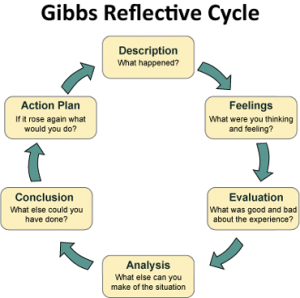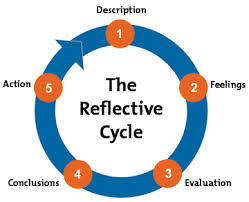Gibbs Reflective cycle
(Based on a Mindtools article)
 Many people find that they learn best from experience.However, if they don’t reflect on their experience, and if they don’t consciously think about how they could do better next time, it’s hard for them to learn anything at all.
Many people find that they learn best from experience.However, if they don’t reflect on their experience, and if they don’t consciously think about how they could do better next time, it’s hard for them to learn anything at all.
This is where Gibbs’ Reflective Cycle is useful. You can use it to help your people make sense of situations at work, so that they can understand what they did well and what they could do better in the future. It fits well into Coaching practice, especially where people want to work on what could be described as “liability behaviours”.
About the Model
Professor Graham Gibbs published his Reflective Cycle in his 1988 book “Learning by Doing.” It’s particularly useful for helping people learn from situations that they experience regularly, especially when these don’t go well.
There are five stages in the cycle:
- Description
- Feelings
- Evaluation
- Conclusions
- Action.
You can use it to help people think about how they deal with situations, so that they can understand what they did well, and reflect on where they need to improve.
The 5 stages
 To structure a coaching session using Gibbs’ Cycle, choose a situation to analyse and then work through the steps below:
To structure a coaching session using Gibbs’ Cycle, choose a situation to analyse and then work through the steps below:
Step 1: Description
First, ask the person you’re coaching to describe the situation in detail. At this stage, you simply want to know what happened – you’ll draw conclusions later.
Consider asking questions like these to help them describe the situation:
- When and where did this happen?
- Why were you there?
- Who else was there?
- What happened?
- What did you do?
- What did other people do?
- What was the result of this situation?
Step 2: Feelings
Next, encourage them to talk about what he thought and felt during the experience. At this stage, avoid commenting on their emotions.
Use questions like these to guide the discussion:
- What did you feel before this situation took place?
- What did you feel while this situation took place?
- What do you think other people felt during this situation?
- What did you feel after the situation?
- What do you think about the situation now?
- What do you think other people feel about the situation now?
Step 3: Evaluation
 Now you need to encourage the person you’re coaching to look objectively at what approaches worked, and which ones didn’t.
Now you need to encourage the person you’re coaching to look objectively at what approaches worked, and which ones didn’t.
Ask them:
- What was positive about this situation?
- What was negative?
- What went well?
- What didn’t go so well?
- What did you and other people do to contribute to the situation (either positively or negatively)?
Step 4: Conclusions
Once you’ve evaluated the situation, you can help the person draw conclusions about what happened.
Encourage them to think about the situation again, using the information that you’ve collected so far. Then ask questions like these:
- How could this have been a more positive experience for everyone involved?
- If you were faced with the same situation again, what would you do differently?
- What skills do you need to develop, so that you can handle this type of situation better?
Step 5: Action
You should now have some possible actions that the person can take to deal with similar situations more effectively in the future.
In this last stage, you need to come up with a plan so that they can make these changes.
Once you’ve identified the areas they will work on, encourage them to commit to taking action, and agree a date on which you will both review progress.